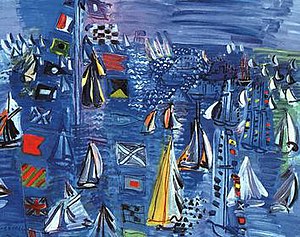Raoul Dufy biography
Raoul Dufy was born in Le Havre, where he began to study art at night while working as an errand boy during the day. When he obtained a small scholarship in 1900 he went to Paris to study with Bonnat. About five years later, he met Matisse and the other Fauve painters, whose color delighted him. Dufy experimented with Fauvism, made some attempts at Cubism, and in the years between 1905 and 1920, earned his living by working on a museum staff designing fabrics, and doing some book illustration. Painting at Honfleur toward the end of World War I, Dufy observed that line moves more rapidly than color does and that the human eye receives the sensation of color more easily than that of movement, thus holding this mental image longer. The painter's perception led to his development of that lightning-fast, calligraphic, short, curved line with which his pen or pencil was forever to move across paper. It also led to his application of color in "diffusions" that were not strictly confined to outlines but sometimes swept across a work in broad bands coloring objects perhaps half-green and half-blue and thus making them part of a lively, moving world held together in tight compositions in which both color and line dance and sparkle.
To this understanding of movement and color Dufy added a love of poetry, music, drawing, painting, and of simply being alive. His personal symbolism, sensitive touch, and feeling for color create a world of fashionable pleasure from which he made a natural transition to textile design, ceramic decoration, and decorative painting. By 1925, his reputation solidly established, he was commissioned to paint murals for many French public buildings. He began to suffer from multiple-arthritis in 1937, and moved to southwestern France for his health. When the disease progressed to the point that he could no longer paint, he came to the United States for cortisone treatment in 1947. After the treatment and a trip to Arizona, Dufy, although not cured, was well enough to return to France and to continue painting until his death in 1953.
Raoul Dufy was born into a large family at Le Havre, in Normandy. He left school at the age of fourteen to work in a coffee-importing company. In 1895, when he was 18, he started taking evening classes in art at Le Havre's École d'Art (municipal art school). The classes were taught by Charles Lhuillier, who had been, forty years earlier, a student of the remarkable French portrait-painter, Ingres. There, Dufy met Raymond Lecourt and Othon Friesz with whom he later shared a studio in Montmartre and to whom he remained a lifelong friend. During this period, Dufy painted mostly Norman landscapes in watercolors.
In 1900, after a year of military service, Dufy won a scholarship to the École nationale supérieure des Beaux-Arts in Paris, where again he crossed paths with Othon Friesz. (He was there whenGeorges Braque also was studying.) He concentrated on improving his drawing skills. The impressionist landscape painters, such as Claude Monet and Camille Pissarro, influenced Dufy profoundly. His first exhibition (at the Exhibition of French Artists) took place in 1901. Introduced to Berthe Weill in 1902, Dufy showed his work in her gallery. Then he exhibited again in 1903 at the Salon des Independants. A boost to his confidence: the painter, Maurice Denis, bought one of his paintings. Dufy continued to paint, often in the vicinity of Le Havre, and, in particular, on the beach at Sainte-Adresse, made famous by Eugene Boudin and Claude Monet. In 1904, with his friend, Albert Marquet, he worked in Fecamp on the English Channel (La Manche).
Henri Matisse's Luxe, Calme et Volupté, which Dufy saw at the Salon des Indépendants in 1905, was a revelation to the young artist, and it directed his interests towards Fauvism. Les Fauves (the wild beasts) emphasized bright color and bold contours in their work. Dufy's painting reflected this aesthetic until about 1909, when contact with the work of Paul Cézanne led him to adopt a somewhat subtler technique. It was not until 1920, however, after he had flirted briefly with yet another style, cubism, that Dufy developed his own distinctive approach. It involved skeletal structures, arranged with foreshortened perspective, and the use of thin washes of color applied quickly, in a manner that came to be known as stenographic.
Dufy's cheerful oils and watercolors depict events of the time period, including yachting scenes, sparkling views of the French Riviera, chic parties, and musical events. The optimistic, fashionably decorative, and illustrative nature of much of his work has meant that his output has been less highly-valued critically than the works of artists who have addressed a wider range of social concerns.
Dufy completed one of the largest paintings ever contemplated, a huge and immensely popular ode to electricity, the fresco La Fée Electricité for the 1937 Exposition Internationale in Paris.
Dufy also acquired a reputation as an illustrator and as a commercial artist. He changed the face of local fashion and fabric design with his work for Paul Poiret. He painted murals for public buildings; he also produced a huge number of tapestries and ceramic designs. His plates appear in books by Guillaume Apollinaire, Stéphane Mallarmé, and André Gide.
In the late 1940s and early 1950s Dufy exhibited at the annual Salon des Tuileries in Paris. Dufy died at Forcalquier, France, on 23 March 1953, and he was buried near Matisse in the Cimiez Monastery Cemetery in Cimiez, a suburb of the city of Nice.








































































































No comments:
Post a Comment